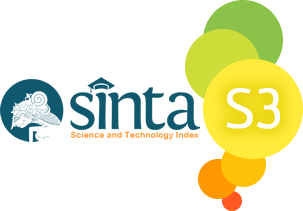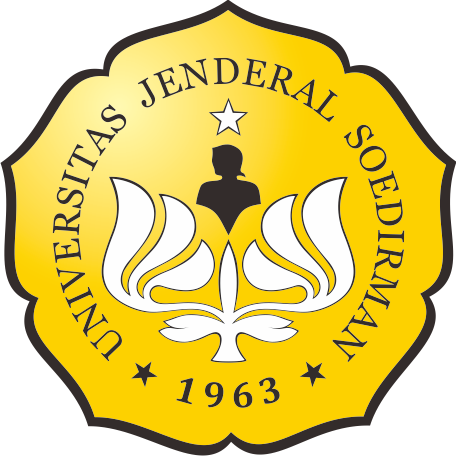STUDI MORFOMETRI DAN TINGKAT HERBIVORI DAUN MANGROVE DI SEGARA ANAKAN CILACAP
Abstract
Mangrove communities are part of the natural coastal ecosystems that have a vital role, such as the greatest source of organic material for the surrounding aquatic environment. A variety of ecological phenomenon often happens recently, either directly or indirectly affects the change of mangrove vegetations. Leaf is one of the plant organs that change shape according to the condition of the mangroves and the aquatic environment where the plant lives. The common changes of the leaves are the symmetry (morphometry), the size, and the shape. Mangrove leaves are also subjected to herbivory (predation), that will result in reduced leaf area of the photosynthesis and lowered the production of organic matter to the surrounding waters. This research aimed to determine the morphometric variation and herbivory rates of mangrove leaves at Segara Anakan Cilacap. Mangrove samples were Aegiceras corniculatum, Avicennia marina, Ceriops tagal, Rhizophora apiculata, and Sonneratia caseolaris. The study used survey method with stratified random sampling technique. The results showed morphometric variations of the five species were three variations, while the average herbivory rate from highest to lowest were: Avicennia marina (7.46%), Sonneratia caseolaris (6.91%), Rhizophora apiculata (4.08%), Aegiceras corniculatum (3.42%) and Ceriops tagal (3.00%). The difference of age and species of leves affected the herbivory level.
Keywords
Full Text:
PDFReferences
Ardli ER, Yani E, Widyastuti A. 2010. Distribusi spasial dan dinamika populasi Polymesoda erosa di ekosistem mangrove Segara Anakan Cilacap, sebagai acuan restocking dan konservasi. Fakultas Biologi Universitas Jenderal Soedirman. Purwokerto.
Barret GW, Rossenberg. 1981. Sterss effect on natural ecosystem. New York: John Wiley & Sons Ltd.
Basset Y. 1991. The spatial distribution of herbivory, mines and galls within an Australia rain forest trees. Biotropica. 23(3):271–281. https://doi.org/10.2307/2388204
Borazan A, Babac MT. 2003. Morphopetric leaf variation in Oaks (Quercus) of Bolu Turkey-Ann. Bot. Fennici. 40: 233‒242.
Cooke FP, Brown JP, Mole S. 1984. Herbivore enzyme inhibitor, nitrogen and leaf structure of young and mature leaves in a tropical forest. Biotropica. 16(4):257‒263. https://doi.org/10.2307/2387933
Franswoth EJ, Ellison AM. 1993. Pattern of herbivory in Belizean mangrove swamps. Biotropica. 23(4b):555‒565.
Hadi M, Tarwtjo U, Rahadian R. 2003. Buku Ajar: Biologi Insekta. Semarang: FMIPA Universitas Diponegoro.
Johnstone IM. 1981. Consumption of leaves by herbivores in mixed mangrove stands. Biotropica. 13(4):252–29. https://doi.org/10.2307/2387803
Khusna E. 2008. Studi morfometri dan tingkat herbivori daun mangrove Rhizophora mucronata Lamk dan Avicennia marina (Forsk) Vierh di Kecamatan Legon Kulon dan Pusakanegara, Subang, Jawa Barat. [Skripsi]. FPIK Universitas Diponegoro. Semarang.
Lowman MD. 1983. An Assessment of techniques for measuring herbivory: is rainforest defoliation more intense than we thought. Biotropica. 16(4):264‒268. https://doi.org/10.2307/2387934
Murphy DH. 1990. The natural history of insect herbivory on mangrove in near Singapore. Raffles Bulletin of Zoology. 38(2):119‒203.
Newbery DM, De Foresta H. 1985. Herbivory and defense in pioneer, gap and understory trees of tropical rain forest in French Guiana. Biotropica. 17:238-244 https://doi.org/10.2307/2388224
Noughton SJ. 1983. Compensatory plant growth as a response to herbivory. Oikos. 40:329‒336. https://doi.org/10.2307/3544305
Nurakhman. 2002. Kondisi Ekosistem mangrove berdasarkan indikator kualitas lingkungan dan pengukuran morfometrik daun di kawasan hutan lindung Angke-Kapuk, Jakarta Utara [skripsi]. Universitas Diponegoro-Semarang.
Nybakken J.W. 1992. Biologi Laut: Suatu pendekatan ekologis [diterjemahkan oleh Eidman M, Koesoebiono DG, Bengen MH, Subarjo S]. Jakarta: PT Gramedia Pustaka Utama.
Onuf CF, Teal JM, Valiela I. 1997. Interaction of nutrients, plant growth and herbivory in a mangrove ecosytem. Ecology. 58:514‒526. https://doi.org/10.2307/1939001
Pribadi R. 1998. The ecology of mangrove vegetation in Bintuni Bay, Irian Jaya, Indonesia [thesis]. Departemen of Biological and Molecular Sciences University of Stirling-Scotland.
Saenger P. 2002. Mangrove ecology, silviculture and conservation. London: Kluwer Academic Publisher. https://doi.org/10.1007/978-94-015-9962-7
Stowe KA. 1995. Intracrown distribution of herbivory damage on Laguncularia racemosa in tidally influenced riparian habitat. Biotropica. 27(4):509–512. https://doi.org/10.2307/2388964
Yuwono E, Jennerjahn TC, Nordhaus I, Ardli ER, Sastranegara MH, Pribadi R. 2007. Ecological status of Segara Anakan, Indonesia: A mangrove-fringed Lagoon affected by human activities. Asian Journal of Water, Environment and Pollution. 4(1):61–70.
Article Reads
Total: 2349 Abstract: 1220 PDF: 1129Refbacks
- There are currently no refbacks.

This work is licensed under a Creative Commons Attribution-ShareAlike 4.0 International License.
This website is maintained by:
Bio Publisher
The Faculty of Biology Publishing
Faculty of Biology
Universitas Jenderal Soedirman
Jalan dr. Suparno 63 Grendeng
Purwokerto 53122
Telephone: +62-281-625865
Email: biologi@unsoed.ac.id
T his website uses:
OJS | Open Journal System
A free journal management and publishing system that has been developed by the PKP (Public Knowledge Project) version 2.4.8.0.
All article content metadata are registered to:
Crossref
An official nonprofit Registration Agency of the International Digital Object Identifier (DOI) Foundation.
Articles in this journal are indexed by:









